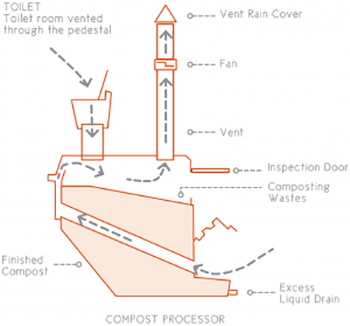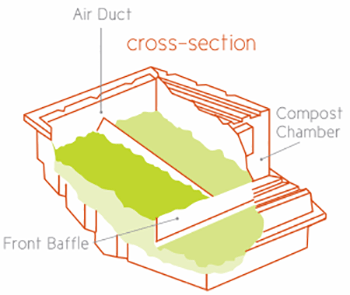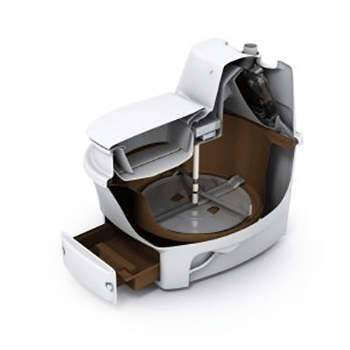The process works on the same principle as an ordinary garden compost bin. Waste is collected in the composting chamber along with carbon rich material such as wood shavings and garden clippings to obtain a good carbon/nitrogen ratio for composting. Here the materials gradually decompose in the chamber’s aerated environment. Baffles and air channels in the tank control air flow and this accelerates the composting process. A continuously operating fan pulls air down the toilet fixture and out through a vent stack creating a completely odourless bathroom at all times.


The Clivus is the most reliable and efficient composting toilet because of its superior design.
An aerated micro-environment is crucial to any composting process and is maintained through the drawing effect of the ventilation fan and air channels through the compost pile. This unique system ensures complete decomposition of the waste during its long residence time.
A large inspection door is also unique to the Clivus and allows the user to easily check that the system is functioning efficiently.
Another design feature of the Clivus composting chamber is that access to the old and new compost are kept separate. The older, fully composted material settles to the bottom of the chamber where it is easily removed via the front access hatch.
A continuous composting process
The Clivus system is based on a “continuous” composting process in one large chamber, as against multiple smaller chambers that require a restart of the process after emptying. As the organic material decomposes it reduces in volume by up to 90%. The compost pile is therefore always “shrinking in the middle” whilst new material is being added to the top, and finished compost is removed from the bottom of the pile when appropriate.
Advantages of a continuous composting process
- As only one large composting chamber is used, the contents are in a more stable environment and are kept moist through normal use. In “batch” systems where the full chamber must be moved away while the next chamber is being filled, the first chamber often dries out and does not fully decompose. This problem does not arise with a Clivus!
- There is little risk of overfilling the composting chamber due to the Clivus’ greater capacity, which makes it very tolerant to extremes in the rate of usage.
- Only a relatively small and manageable amount of finished compost is removed at any one time. This means there is no heavy lifting or moving of smelling bins.
- A larger area of compost bed means there will be greater liquid evaporation without the use of heaters. Urine is well-treated by passing through the larger compost bed and converted to an innocuous liquid.
- The relatively simple design of the Clivus renders it far less susceptible to mechanical problems than other composting systems.
How an EcoLet Manual, Auto and Auto XL work


EcoLet uses modern technology to accelerate and optimise natural biological decomposition, evaporate excess liquid and to exhaust odours and water vapour, all within an attractive home appliance that is easy to use and economical to operate.
The ventilation pipe leads moist air away and ventilates the entire bathroom. Mixing arms help aerate the compost and sift it into the humus tray. The adjustable thermostat combined with recirculation of the heated air results in a very low energy cost. The fan drives warm air through the air channels to remove moisture, to provide the compost with oxygen and to warm it up to optimum temperature. For maximum usage rates the toilet room should be at least 18°C.
The humus collection tray in the bottom of the unit is emptied periodically, depending on usage. More humus-starter is added as needed to maintain a balanced composting mix.
